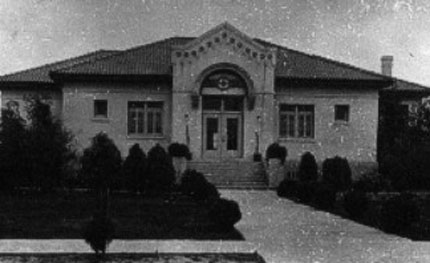|
THE
HISTORY

Laurel School, 1910
In
1769, Spanish explorer Gaspar de Portola spent
a July night in what would become Brea. He reportedly
found the native Indians "dirty," but
didn't realize they frequently smeared themselves
with crude oil as medicine.
In
fact, while Portola slept at the mouth of Brea
Canyon on his way to Monterey Bay, Brea's future
bubbled beneath him.
Brea's
early reliance on the oil industry has waned since
the "black gold" rush began less than
100 years ago. But back then, the villages of
Randolph - Brea's first name - and Olinda grew
as oil-riggers and their families came to town.
Today,
Brea officials consider the city one of Orange
County's most prosperous, with new housing, an
expanded shopping mall and a large downtown redevelopment
project.
Brea's
future began in 1894, when landowner Abel Stearns
sold 1,200 acres on the western edge of what then
was Olinda village to the Union Oil Co. The first
well was drilled a year later, and soon the surrounding
hills were thick with wooden oil towers, according
to "History of Brea, California: From Early
Oil Field Days to 1950" by Purl Hardy.
Randolph
was built to the west of Olinda in 1908 for oil
workers and their families. It reportedly was
named for Epes Randolph, an engineer for the Pacific
Electric Railway, which stopped at the little
township on its Los Angeles-Yorba Linda route,
Hardy wrote.
In
1911, the town's name was changed to Brea, Spanish
for 'tar'. By 1917 there were 732 people
in Brea, and they incorporated as Orange County's
eighth city.
Brea
now covers 10 square miles and has almost 40,000
residents. A $120 million expansion was completed
a few years ago at the Brea Mall along with many
other redevelopment projects.
Historical
Site:
Olinda
Townsite - 4442 Carbon Canyon Road
Oil was discovered about 1896 in what is now Carbon
Canyon Regional Park. A town called Olinda was
built. But the town dwindled and in 1965, 114
acres were set aside for a park.
Brea
Museum and Heritage Center - 495 S. Brea Blvd
The museum occupies the renovated HAmerican Legion
Hall which was built in 1920 at the corner of
Elm and Pomona Ave. There
are numerous exhibits in the museum which reflects
the area’s history.
|


![]()


